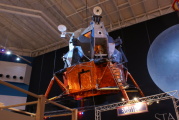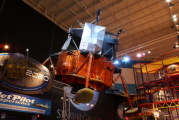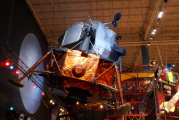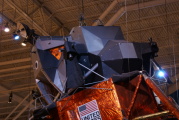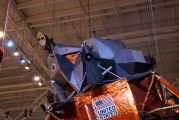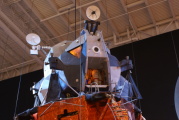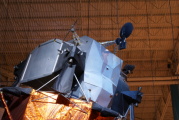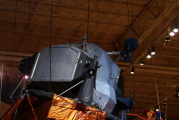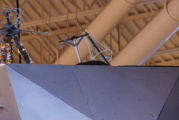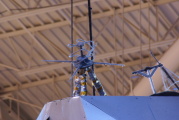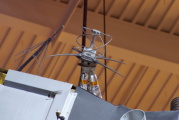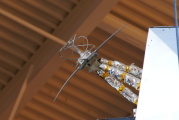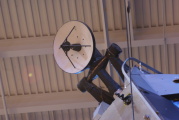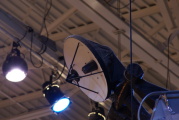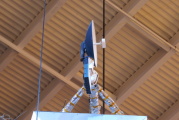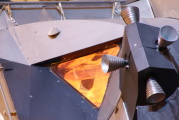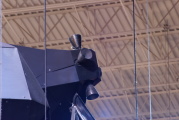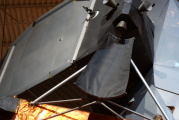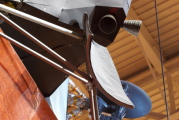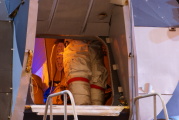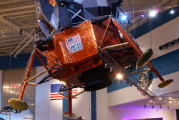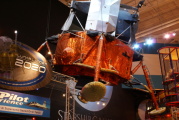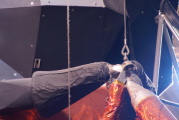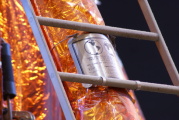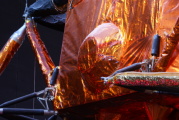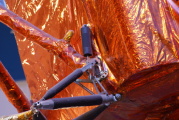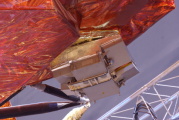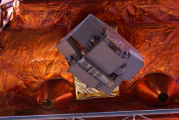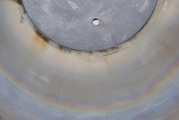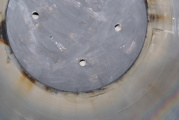Return to Space Center Houston
Lunar Test Article 8 (LTA-8)
Lunar Test Article 8 (LTA-8, sometimes also referred to as LTA-8A) was the thermal vacuum test article and was the first production, man-rated lunar module. LM-1 and LM-2 preceded it (and LM-1 was launched several months before testing with LTA-8 got underway), although both of those lunar modules were intended to be unmanned vehicles. As an early lunar module, LTA-8 did not incorporate engineering changes present in the manned lunar modules (including modifications to the propellant fluid-distribution system fittings and changing the minimum wire size from 22 gauge to 18 gauge), and problems in these areas compounded problems normally associated with testing a new spacecraft .
LTA-8, along with LTA-9, was originally envisioned as a dynamic test and evaluation vehicle. They were to be operated "both tethered and free flight". The "tethered operation" would involve either being suspended from scaffolding such as Langley Research Center's Lunar Landing Research Facility or using a helicopter as its means of support. The "atmospheric free flight" would have involved "a modified LEM with lift provided solely by the descent engine" and installing upgraded landing gear capable of 1-G operation (which seems a whole lot like designing a new spacecraft, especially since the descent propulsion system (DPS) engine was designed to operate in a vacuum...). Plans were also made to send LTA-8 to White Sands Missile Range to undergo full duration firings in a test stand. (Read all about this in LTA-8 and LTA-9 Preliminary Design Summary Report - Integrated System Dynamic Test and Evaluation Vehicles.) The atmospheric tests (and LTA-9 as well) were eventually cancelled and LTA-8 was delivered to Manned Spacecraft Center's thermal vacuum test chamber "B", the Space Environment Simulation Laboratory (SESL), on September 18, 1967.
LTA-8 underwent separate series of tests in support of LM-3 (Apollo 9, an earth-orbital mission) and LM-5 (Apollo 11, the lunar landing mission). The objectives of these tests included demonstrating that the lunar module's environmental control system could provide a habitable environment and temperature in both the cabin and pressure suit loops and that the cabin atmosphere and suit loop contained no contaminants which would affect the crew, verify that the heat generated by equipment could be properly dissipated, demonstrate that the cabin leak rate was acceptable, verify that the cabin could be depressurized in simulated lunar conditions when anti-bacterial filters installed in the relief and dump valves, and demonstrate that the lithium hydroxide cartridges (used to remove carbon dioxide from the air) could be replaced when the cabin was depressurized.
The Space Environment Simulation Laboratory consists of a series of vacuum chambers, two of which were large enough to hold the Apollo spacecraft. The vacuum chambers employ carbon arc solar simulators, lamps to subject the chambers' contents to anticipated solar heating. The chambers also contain black, nitrogen-cooled heat sink panels to cool the chambers' contents down to 100°K. Chamber A was used to conduct tests on the command module (the 2TV-1 tests), while Chamber B was used for LTA-8.
The tests were designed to test the spacecraft under simulated mission conditions, for simulated mission durations. Tests conducted on LTA-8 ranged from 3½ to 12 days in length. However, since the lunar module was designed for use under 1/6 G, it was not feasible to keep LTA-8 manned for the full duration in a 1G environment. The crew manned the LM in shifts ranging from 9 to 12 hours, ingressing and egressing the vehicle while under full vacuum conditions.
A crew patch was designed for the testing. While the patch depicts "Irwin-Bull" (John Bull and Apollo 15 astronaut Jim Irwin), Bull did not partake in the testing due to a medical condition and was replaced by Grumman test pilot Gerald Gibbons. The crews for the various tests varied, and Grumman test pilot Glennon Kingsley and Air Force Maj. Joseph Gagliano also manned LTA-8 (although there's no note as to whether the Kingsley-Gagliano crew wore the "Irwin-Bull" patch :-)
Additional information on the SESL can be found at Manrating Features of the Space Environment Simulation Chambers [direct link to 3.4 meg PDF]. An overview of the LTA-8 tests can be found on this forum thread; scroll down to "Reply #12" and "Reply #13". Photos from the LTA-8 testing can be found at the Project Apollo Archive Image Gallery; select "Early Apollo" and then scroll down to the "LTA-8" section. NASA image S67-27042 is a photo of LTA-8 during manufacture.
More detailed information on the 2TV-1 and LTA-8 tests can be found in To Create Space on Earth: The Space Environment Simulation Laboratory and Project Apollo, Manned Operations for the Apollo Lunar Module in a Simulated Space Environment, the Apollo Experience Report: Manned Thermal-Vacuum Testing of Spacecraft, and the Apollo Experience Report: Lunar Module Environmental Control Subsystem.
Return to Space Center Houston

